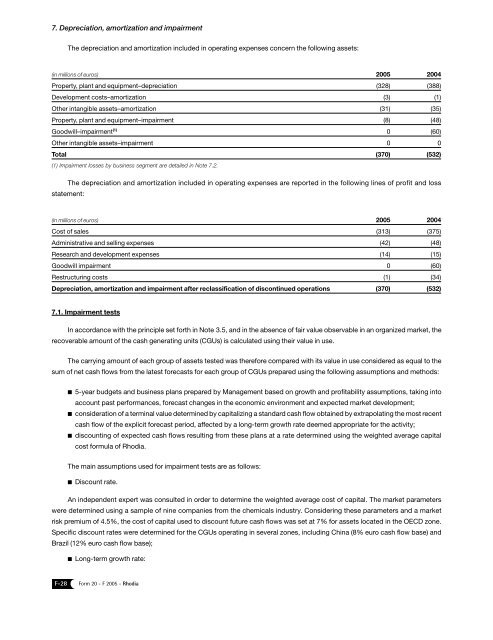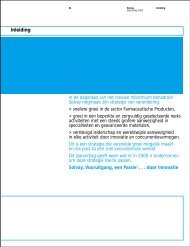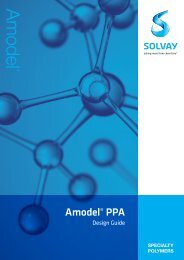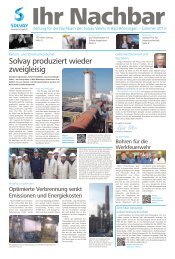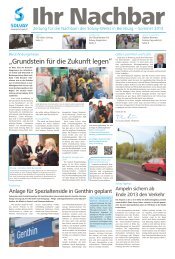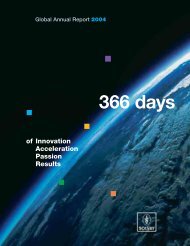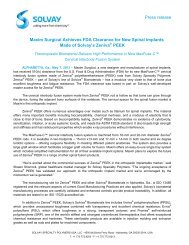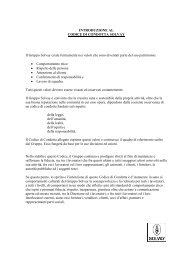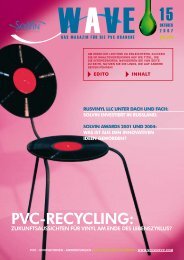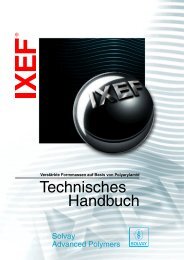Form 20-F 2005
Form 20-F 2005
Form 20-F 2005
You also want an ePaper? Increase the reach of your titles
YUMPU automatically turns print PDFs into web optimized ePapers that Google loves.
7. Depreciation, amortization and impairment<br />
The depreciation and amortization included in operating expenses concern the following assets:<br />
(in millions of euros) <strong>20</strong>05 <strong>20</strong>04<br />
Property, plant and equipment–depreciation (328) (388)<br />
Development costs–amortization (3) (1)<br />
Other intangible assets–amortization (31) (35)<br />
Property, plant and equipment–impairment (8) (48)<br />
Goodwill–impairment (1) 0 (60)<br />
Other intangible assets–impairment 0 0<br />
Total (370) (532)<br />
(1) Impairment losses by business segment are detailed in Note 7.2.<br />
The depreciation and amortization included in operating expenses are reported in the following lines of profit and loss<br />
statement:<br />
(in millions of euros) <strong>20</strong>05 <strong>20</strong>04<br />
Cost of sales (313) (375)<br />
Administrative and selling expenses (42) (48)<br />
Research and development expenses (14) (15)<br />
Goodwill impairment 0 (60)<br />
Restructuring costs (1) (34)<br />
Depreciation, amortization and impairment after reclassification of discontinued operations (370) (532)<br />
7.1. Impairment tests<br />
In accordance with the principle set forth in Note 3.5, and in the absence of fair value observable in an organized market, the<br />
recoverable amount of the cash generating units (CGUs) is calculated using their value in use.<br />
The carrying amount of each group of assets tested was therefore compared with its value in use considered as equal to the<br />
sum of net cash flows from the latest forecasts for each group of CGUs prepared using the following assumptions and methods:<br />
5-year budgets and business plans prepared by Management based on growth and profitability assumptions, taking into<br />
account past performances, forecast changes in the economic environment and expected market development;<br />
consideration of a terminal value determined by capitalizing a standard cash flow obtained by extrapolating the most recent<br />
cash flow of the explicit forecast period, affected by a long-term growth rate deemed appropriate for the activity;<br />
discounting of expected cash flows resulting from these plans at a rate determined using the weighted average capital<br />
cost formula of Rhodia.<br />
The main assumptions used for impairment tests are as follows:<br />
Discount rate.<br />
An independent expert was consulted in order to determine the weighted average cost of capital. The market parameters<br />
were determined using a sample of nine companies from the chemicals industry. Considering these parameters and a market<br />
risk premium of 4.5%, the cost of capital used to discount future cash flows was set at 7% for assets located in the OECD zone.<br />
Specific discount rates were determined for the CGUs operating in several zones, including China (8% euro cash flow base) and<br />
Brazil (12% euro cash flow base);<br />
Long-term growth rate:<br />
F-28 <strong>Form</strong> <strong>20</strong> - F <strong>20</strong>05 - Rhodia


